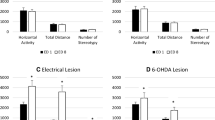Abstract
Dopaminergic systems appear to exert considerable control over locomotor activity. Although dopamine neurons are located in relatively close proximity within the mesencephalon, their axons project to more diffuse areas, perhaps reflecting some underlying heterogeneity in their function. The purpose of this study was to determine whether dopamine agonists differentially affect activity by acting upon distinct dopamine systems. Bilateral radio-frequency lesions of area A10 in rats failed to affect spontaneous open-field behavior over a 1-month postoperative period. When injected with 1 mg/kg of apomorphine, however, experimental rats more than doubled their activity as compared to the response of sham-operated controls. In contrast, no difference between the two groups of animals was observed in terms of increased activity following 3 mg/kg of either d-amphetamine or methylphenidate. These results are consistent with previous work indicating the involvement of ventromedial mesencephalic dopamine somata in the control of locomotor activity. The data suggest, however, that systems in addition to the dopaminergic mesolimbic projection are responsible, in part, for the hyperactivity elicited by d-amphetamine or methylphenidate.
Similar content being viewed by others
References
Butcher LL, Hodge GK (1979) Selective bilateral lesions of pars compacta of the substantia nigra: effects on motor processes and ingestive behaviors. In: Poirier LJ, Sourkes TL, Bédard P (eds) The extrapyramidal system and its disorders: VI International Conference on Parkinson's Disease, Advances in Neurology, vol 24. Raven Press, New York, pp 71–82
Cole S (1978) Brain mechanisms of amphetamine-induced anorexia, locomotion, and stereotypy: a review. Neurosci Biobehav Rev 2:89–100
Costall B, Naylor RJ (1975) The behavioural effects of dopamine applied intercerebrally to areas of the mesolimbic system. Eur J Pharmacol 32:87–92
Fink JS, Smith GP (1979) Decreased locomotor and investigatory exploration after denervation of catecholamine terminal fields in the forebrain of rats. J Comp Physiol Psychol 93:34–65
Hodge GK (1977) Analysis of the role played by the substantia nigra in the mediation of ingestive, locomotor, and rotational behaviors as revealed by surgical and pharmacological manipulations. (Doctoral dissertation, UCLA, 1977). Dissert Abstr Int 38:953B-954B (Ann Arbor, MI: University Microfilms International No. 77-17, 229)
Hodge GK, Butcher LL (1979) Role of pars compacta of the substantia nigra in circling behavior. Pharmacol Biochem Behav 10:695–709
Hodge GK, Butcher LL (1980) Pars compacta of the substantia nigra modulates motor activity but is not involved importantly in regulating food and water intake. Naunyn-Schmiedeberg's Arch Pharmacol 313:51–67
Isaacson RL, Yongue B, McLearn D (1978) Dopamine agonists: their effect on locomotion and exploration. Behav Biol 23:163–179
Jackson DM, Andén N-E, Dahlström A (1975) A functional effect of dopamine in the nucleus accumbens and in some other dopamine-rich parts of the rat brain. Psychopharmacologia 45:139–149
Kelly PH, Iversen SD (1976) Selective 6OHDA-induced destruction of mesolimbic dopamine neurons: abolition of psychostimulant-induced locomotor activity in rats. Eur J Pharmacol 40:45–56
Koob GF, Riley SJ, Smith SC, Robbins TW (1978) Effects of 6-hydroxydopamine lesions of the nucleus accumbens septi and olfactory tubercle on feeding, locomotor activity, and amphetamine anorexia in the rat. J Comp Physiol Psychol 92:917–927
Le Moal M, Stinus L, Galey D (1976) Radiofrequency lesion of the ventral mesencephalic tegmentum: neurological and behavioral considerations. Exp Neurol 50:521–535
Lindvall O, Björklund A (1974) The organization of the ascending catecholamine neuron systems in the rat brain as revealed by the glyoxylic acid fluorescence method. Acta Physiol Scand (Suppl) 412:1–48
Pijnenburg AJJ, Honig WMM, Van Der Heyden JAM, Van Rossum JM (1976) Effects of chemical stimulation of the mesolimbic dopamine system upon locomotor activity. Eur J Pharmacol 35:45–58
Rebec GV, Segal DS (1978) Dose-dependent biphasic alterations in the spontaneous activity of neurons in the rat neostriatum produced by d-amphetamine and methylphenidate. Brain Res 150:353–366
Schoenfeld R, Uretsky N (1972) Altered response to apomorphine in 6-hydroxydopamine-treated rats. Eur J Pharmacol 19:115–118
Tassin J, Stinus L, Simon H, Blanc H, Thierry A, Le Moal M, Cardo B, Glowinski J (1978) Relationship between the locomotor hyperactivity induced by A10 lesions and the destruction of the fronto-cortical dopaminergic innervation in the rat. Brain Res 141:267–281
Ungerstedt U (1971) Postsynaptic supersensitivity after 6-hydroxydopamine induced degeneration of the nigro-striatal dopamine system. Acta Physiol Scand (Suppl) 367:69–93
Winer BJ (1971) Statistical principles in experimental design, 2nd ed. McGraw-Hill, New York
Wirtshafter D, Asin KE, Kent EW (1978) Nucleus accumbens lesions reduce amphetamine hyperthermia but not hyperactivity. Eur J Pharmacol 51:449–452
Author information
Authors and Affiliations
Rights and permissions
About this article
Cite this article
Hodge, G.K., Boyeson, M.G. & Linn, R.T. Dopaminergic agonists differentially affect open-field activity of rats with A10 lesions. Psychopharmacology 73, 39–42 (1981). https://doi.org/10.1007/BF00431098
Received:
Accepted:
Issue Date:
DOI: https://doi.org/10.1007/BF00431098




